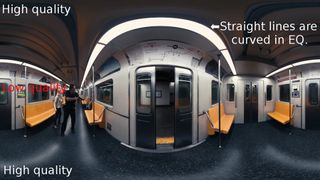YouTube is using cartography to improve virtual reality videos – here's how it works
Old-school map making meets new-school video

It's hard to believe it's already more than two years since Google first brought virtual reality video to YouTube, only to expand that idea out to its Daydream View headset with a dedicated YouTube VR app a year later.
Fast-forward to today, and YouTube is teaming up with Daydream once more to improve the quality of VR video streaming using a skill predating modern civilization: map making.
YouTube is investigating new ways to translate the spherical, 3D world to a 2D surface such as a screen using projections - a cartography technique that converts our globe onto a flat map.
By finding more effective projections, YouTube hopes to create a more uniform resolution across every angle of its 360-degree video content, meaning crisper, better-looking videos while keeping bandwidth demands reasonable.
Mercator Maps & More
Going back to old-school maps for a second, it's a lesser-known fact that there's no way to create a truly accurate 2D depiction of the Earth. (Google even points to this fun xkcd comic to show us just how many different kinds of projections there are.)
Projections are a geometric method of making those depictions as close to genuine as possible, but there's always a trade-off of some kind.
For example, the Mercator projection of the Earth - probably the one most people are familiar with - is fairly accurate around the equator, but landmasses near the poles like Greenland and Antarctica become comically larger than reality.
Get daily insight, inspiration and deals in your inbox
Get the hottest deals available in your inbox plus news, reviews, opinion, analysis and more from the TechRadar team.
How does this pertain to VR? Well, YouTube uses a similar equirectangular projection for VR videos that is easy to edit and doesn't make your internet connection chug, but also has the most clarity near the poles of the video. This means the best-looking parts of the video are at your feet and above your head rather than in front of your eyes.

Now, YouTube is bringing up Equi-Angular Cubemap (EAC) projection as a new standard, combining cubemap projections used in video game skyboxes with equirectangular projection.
The result? A better resolution in VR, regardless of which direction you're gazing. The image below shows a 720p video played on a 1080p-capable Google Cardboard viewer, and the difference in quality between the two projections is pretty clear - no pun intended.

YouTube is also improving its projection mesh to better compliment EAC visuals, and is rolling out the technology to Android platforms starting today, with iOS and desktop support to come in the near future.
For those without a minor in cartography or a background in GIS, YouTube keeps its guidelines for uploading optimized VR video content on its support page.

